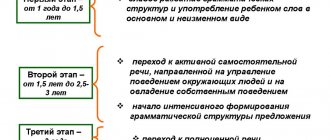When to see a doctor
By the age of 4, children know up to 2000 words, speak clearly, pronouncing words clearly. In speech they use extended phrases of several words. They know how to inflect words and use them correctly in a sentence. They show interest in new words and understand the plot of a fairy tale or short story. Difficulties can be caused by complex words, hissing and sonorant sounds. But these are physiological norms that do not require specialist intervention.
Delayed speech development in children 4 years old can be suspected when they have deviations: in the rate of speech, pronunciation of sounds. Because of problems, the baby prefers to remain silent or speaks fragmentarily.
IRR at 4 years of age increases the likelihood of neurological and even mental abnormalities. An inferiority complex gradually develops, the baby is embarrassed or afraid to communicate with peers, and behaves separately. In the future, this will affect the learning process, academic performance and mastery of the school curriculum. Children whose parents ignore the child’s problem and do not engage in his development are especially in a difficult situation.
Therefore, at the first signs of a speech disorder, you should consult a doctor and begin treatment.
Forecasts and consequences: what to expect?
The effectiveness of treatment depends on many factors. The main ones are the age of the small patient, the severity of the delay in the child’s mental speech development and primary diseases.
Unfortunately, with deep-seated disorders or therapy started in 5-6 year old children, one cannot expect great results. Only in 0.2% of cases out of 100% is it possible that he will start talking. If a child has not mastered speech at the age of 7, he will never speak again.
If the parents turned for help when the baby was 2–3 years old, then there is every chance of a full recovery. In this case, everything depends on the degree of underdevelopment, the participation of parents and the methods used for treatment.
If parents expect that the child will speak on his own sooner or later, they are only wasting time. If this is not the individual pace of development of a particular baby, but really a problem, it will not go away on its own. Against the background of mental and speech underdevelopment, children suffer from poor memory and thinking, perceive and process information distortedly, and cannot concentrate attention. In the future, this leads to changes in personality - the child becomes irritable, closed, uncommunicative, and develops a feeling of inferiority.
Peculiarities of manifestation of delayed speech development in children 4 years old
Features of delayed speech development in children 4 years old are slow or fast speech, blurred sounds, omissions of letters or syllables. Some children do not pronounce words at all or abbreviate them, replacing words with syllables, gestures, and facial expressions.
Characteristic symptoms:
- difficulties in formulating the question and in answering the question addressed to him; the answers are usually monosyllabic (“yes”, “no”, “there”, “here”);
- poor vocabulary - usually uses only those words that are used in everyday life;
- incorrect pronunciation of complex words;
- skipping syllables and sounds;
- lack of skills in composing a simple story or sentence based on a picture;
- replacing words that sound similar;
- There are no hissing or whistling sounds in the articulation, or the patient pronounces them incorrectly;
- replacing sounds with easier ones to pronounce;
- lack of criticism of speech errors in oneself and other people.
Diagnosis of speech disorders
To check on your own how things are going with speech disorders in a child who speaks incomprehensibly, you can conduct several simple tests. To study vocabulary, he is asked to name animals, seasons, dishes, toys, furniture from pictures.
Children are asked to name objects, phenomena, qualities of objects, to carry out an assignment (draw something, bring an object or toy). To find out how they can change words, they offer the following tasks:
- form the plural (nose – noses, chair – chairs),
- offer to count objects, determining how he coordinates nouns with numerals (one book, two books, etc.);
- say “affectionately” (doll - doll, bed - crib).
To determine the level of development of phrasal speech, children are asked to complete a sentence started by an adult: “The boy... is playing ball.” For this, pictures with different scenes are used. When observing a child’s speech in everyday life, you need to note for yourself which parts of speech the child uses and evaluate his ability to correctly construct a phrase.
To examine the syllabic structure of a word, the child is offered verbal tasks without using pictures: repeat syllables from different consonants and vowels (lo-se-ku, pi-ka-chu), syllables from the same consonants and different vowels (da-doo-dy-do) , from the same vowels and different consonants (la-ma-ka-sa). To understand whether the child feels the rhythm of speech, they tap the rhythm of a simple word and ask him to repeat it in the same way.
Causes of delayed speech development in children 4 years old
Various reasons lead to 4-year-old developmental disorder. Some of them affect the fetus in the womb, some - during childbirth and after birth.
Antenatal reasons:
- complications of pregnancy, threat of miscarriage, toxicosis, gestosis;
- illnesses of the expectant mother - exacerbation of chronic diseases, infectious and inflammatory, injuries, intoxication, bad habits;
- conditions that led to fetal hypoxia - placental pathology (anomalies, abruption), umbilical cord entanglement.
During childbirth:
- premature birth;
- rapid labor;
- injuries during childbirth;
- inadequate management of labor, use of obstetric forceps.
After childbirth, delayed speech development in children 4 years of age can result from:
- injuries, especially traumatic brain injuries, are dangerous for speech development;
- diseases - neurological, for example, cerebral palsy, encephalopathy;
- unfavorable family situation - conflicts, parents do not care for the child;
- the opposite situation is overprotection, excessive pressure and demanding parents;
- excessive stress - physical (sports), mental (overload with activities).
Predisposing factors are a hereditary predisposition to RRD at 4 years of age. These may be genetic disorders, congenital abnormalities of the nervous system,
Psychomotor development delay (PMDD)
Delayed psychomotor development is diagnosed in many young children, which may be caused by minor organic changes in the state of the brain or disruption of its functioning. Such changes can be congenital, result from a birth injury, or be acquired by a child during life. In the latter case, PMTCT may be the result of a hereditary predisposition, as a result of which manifestations of delayed psychomotor development may occur against the background of an infectious disease, poisoning, metabolic disorders and social factors. Therefore, the impetus for the development of MTCT can be inattention to the child, lack of love for him, pedagogical neglect, poor living conditions, etc.
Thus, a distinction is made between nonspecific and specific delay in psychomotor development. With a nonspecific or benign delay, there are no brain pathologies, due to which it can be easily corrected and, with the creation of an adequate external environment and special conditions, goes away completely, and the child catches up with his peers in all respects.
With specific VMR, damage to certain brain structures is observed, which leads to a lag in the development of motor, mental, and speech functions. This is accompanied by the appearance of characteristic symptom complexes and requires the appointment of treatment appropriate to the situation, without which PMTCT cannot be fully compensated. Initially, it is usually possible to notice a lag in only one of the parameters, but over time, a specific delay in psychomotor development leads to a uniform impairment of all functions.
PVMR can occur with varying degrees of severity, based on which they distinguish:
- PVMR of the 1st degree is a lag in psychomotor development by no more than 1 age interval, with an observed tendency to reduce its severity as the child grows older. With this form, the developmental delay is quickly compensated, and the child catches up with the nature of the development of mental, motor and speech functions, but only if proper treatment is carried out.
- VMR of the 2nd degree is a lag of more than 1 age period against the background of the absence of a tendency towards gradual compensation and a reduction in the severity of the delay in psychomotor development or even a tendency to increase the deficit. With this form, it is very important to choose the right treatment, but this does not guarantee full compensation of psychomotor functions, but can only make it possible to avoid an increase in time deficit as the child grows older.
- 3rd degree PMTCT is a delay in the psychomotor development of a child by more than 1 or even 2 age periods. This is the most severe form of PMTCT, accompanied by a steady increase in the lag in the psychomotor development of a child of the same age. At the same time, motor, speech, and mental functions may not even differ in their developmental tendency.
Signs
Delayed psychomotor development can begin to manifest itself at any period of a child’s life, which determines the nature of the symptoms that arise. Thus, during the neonatal period, the presence of deviations from the norm may be indicated by:
- the child’s apathy, lack of response to feelings of hunger or satiety, fatigue, etc.;
- weakly expressed unconditioned reflexes that tend to quickly fade with repeated irritating influences;
- lack of attempts to raise the head when turning over on the stomach.
At the same time, in newborns with signs of VMR, normal motor activity is observed, and the muscles are in hypertonicity. In the next age period, i.e. from 1 to 3 months, with delayed psychomotor development, short periods of wakefulness and weakness or complete absence of emotional reactions may be observed. As for the period from 3 to 6 months, then at this time the delay in the formation of reflexes should cause parents to sound the alarm, in particular, the fact that the child does not try to roll over from his back to his stomach and rise in his arms.
Signs of VMR become more pronounced at 6-9 months. In this case, the presence of deviations may be indicated by:
- low level of expressed activity during communication and the presence of a small number of playful reactions and gestures;
- weak emotional coloring of emitted sounds, babble;
- lack of ability to grasp objects with 2 fingers;
- lack of attempts to stand up, the child cannot sit up on his own and crawls poorly.
By the age of one year, the baby should already have a huge set of achievements, one of which is walking and active babbling. But with VMTCT, 9-12 month old infants do not use babbling words and do not color them emotionally. Such children can stand with support, but are not yet able to walk due to underdeveloped motor functions.
But, unfortunately, VMR is extremely rarely diagnosed in the first year of life. Usually, signs of deviations from the norm make parents become wary much later. In such situations, they pay attention to:
- emotional immaturity – the child’s mood often changes, he is fussy, unsure of himself, shy, has poor control over his reaction to various activities and has difficulty adapting to a group of peers, for example, in kindergarten;
- attention disorder - it is difficult for a child to concentrate on anything, as a result of which he is constantly distracted from his work, tends to give up halfway (sometimes manifested by the appearance of attention deficit hyperactivity disorder);
- impaired perception of the surrounding world - it is difficult for a child to form a holistic idea of something, as a result of which he fails to recognize a familiar object only by its part and perceive schematic drawings;
- memory impairment – children with VMT may have difficulty remembering new information, get confused in it, and quickly forget;
- speech disorders - mainly manifested by a decrease in the rate of its development, although other types of speech development delay may be present, the nature of which is determined by the severity of the course of VMR;
- lag in the development of thinking - it is difficult for a child to solve logical and other problems;
- lack of formation of gaming activity - games are characterized by poor content and are devoted to everyday topics.
Such signs do not always indicate developmental delay, but their presence is a reason for mandatory consultation with a doctor, and as soon as possible.
Methods of treating RDD at 4 years of age
Correction of delayed speech development in children 4 years old takes place with the participation of a speech therapist, neurologist, psychologist, and ENT doctor. First, a diagnosis is carried out, during which specialists identify the cause of the defect, find out the features of the course of the antenatal, intranatal (childbirth period) and postpartum period. They study the outpatient card, previous diseases, the nature of physical and neuropsychic development up to one year and at an older age.
This is followed by the stage of hardware examination methods to clarify the diagnosis and exclude organic pathology of the ear, brain, and articulation organs. Electroencephalography, X-ray, MRI or CT scan of the brain, and audiometry are performed. After an accurate diagnosis has been made, treatment for mental retardation begins at 4 years of age: it should be comprehensive, using various methods.
Held:
- Drug treatment - nootropics, sedatives, vitamins, as well as herbal medicines;
- Speech therapy correction - speech therapy massage of the tongue, lips, facial muscles, articulation gymnastics, breathing exercises;
- Physiotherapeutic procedures, including magnetic therapy, acupuncture;
- General massage;
- Physiotherapy.
All treatment procedures are prescribed by a specialist. He knows the characteristics of your child’s 4-year-old RRD, the cause, and based on this he selects an individual treatment regimen. It is unacceptable to independently prescribe a drug, even if it is herbal, to change the dose of a medicine prescribed by a doctor or to cancel it.
An important component of successful treatment is eliminating the cause of the defect. Conflicts, quarrels, mental and physical stress should be avoided.
With the timely start of the correctional program, the absence of severe neurological and mental pathology, and the active participation of the child and parents in the treatment process, the prognosis is favorable. Children's pathological pronunciation of sounds disappears, they begin to speak correctly, clearly and expressively. They ask and answer questions competently. The vocabulary is gradually expanding.
A 4-year-old child diagnosed with RRD is being registered at a dispensary. Specialists monitor him and monitor his further development of speech skills. This is necessary to prevent relapse of the disease. If this happens, it is important to start therapy on time.
Correction of ZRR - a case study
The mother of a 2.2 year old boy contacted us. From the anamnesis: complicated pregnancy, premature birth at 36 weeks via ECS. The entire first year of life was observed by a neurologist due to delayed motor development; according to the results of neurosonography, dilation and asymmetry of the lateral ventricles of the brain were observed.
Until the age of 2, the boy did not speak at all; at 2.2 years there was partial onomatopoeia (“meow”, “bang”, “pee-pee”, “top-top”) and several words indicated by the first syllable.
I started studying at home with our speech therapist-defectologist L.V. Tsvetnikova. 2 times a week, completed a course of speech therapy massage and one course of Tomatis therapy. My vocabulary began to rapidly increase, phrasal speech appeared, and I began to memorize and reproduce poems and songs. As a result, at the age of 2.8 years, the diagnosis of RRD by a neurologist was removed.
The role of parents in the treatment of mental retardation at 4 years of age
Eliminating speech development delays in 4-year-old children is a matter for specialists with the appropriate education and skills. But parents also play a big role. First of all, the situation in the family has an impact on the child’s condition, including the development of speech. Conflicts and quarrels, even if the baby is not involved in them, affect the child’s psyche. This is fraught with a slowdown in the pace of development.
In addition, in some families no one takes care of the children. They are left to their own devices. If there are prerequisites, for example, close relatives have a speech pathology, then we can talk about a hereditary factor. Such a child will have speech delays.
The next point is the presence of a person with incorrect speech in your environment. The baby will imitate him and speak incorrectly. Experts recommend protecting your child as much as possible from people with pathological speech. That is why parents should always speak correctly, pronouncing all sounds clearly and slowly. You cannot lisp the baby or distort words - this rule must be followed by all family members.
Overprotection also contributes to delayed speech development in children 4 years old. Don't demand anything supernatural from your child. Each person develops at his own pace. By overloading your son or daughter with activities, without leaving a minute of free time, you only make things worse: this is constant stress for children. This can cause other defects to appear: stuttering, enuresis, sleep disturbances.
What to do if a child speaks poorly?
First, take the situation for granted. Don't be offended by facts. The faster help is provided, the higher the child’s chances of catching up with his peers at school. Secondly, get tested. The child must be examined:
- ENT;
- speech pathologist;
- neurologist;
- psychologist.
Some specialists may recommend undergoing additional examinations. This must be done in order to understand what exactly is preventing the child from developing in accordance with the norms, and to prescribe the correct treatment.









